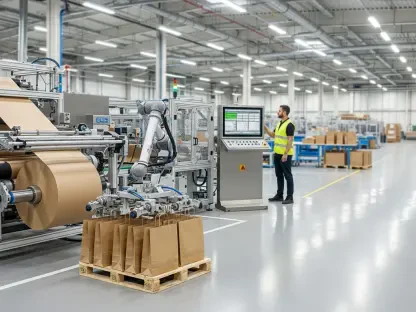The United Kingdom finds itself at a pivotal moment in the evolution of its manufacturing sector, grappling with a significant shortfall in automation and digital technology adoption when compared to leading global economies. Despite holding a prominent position as one of the world’s top economies, the UK’s hesitation to fully integrate robotics and cutting-edge systems has hampered its industrial productivity and competitive edge, posing a threat to sustained economic growth. A comprehensive report from Make UK titled “Making it Smarter” highlights a staggering opportunity, projecting a potential £150 billion increase in GDP by 2035 if the nation can fast-track its industrial modernization. This article explores the pathways through which the UK can reverse its fortunes by adopting successful strategies from international frontrunners such as Germany and Singapore, whose approaches provide a detailed roadmap for revitalizing the manufacturing landscape.
Confronting the Automation Deficit
The depth of the UK’s challenges in manufacturing becomes strikingly apparent when examining its standing on the global robotic density index, where it languishes at 24th place with a mere 112 industrial robots per 10,000 workers—significantly trailing the European Union average. This slow uptake of automation technologies stands as a fundamental barrier to productivity, casting a shadow over critical areas such as wage growth, living standards, and even national security. Small and medium-sized enterprises (SMEs), which constitute a substantial segment of the sector, face the brunt of these challenges, often lacking the financial resources and institutional support needed to implement advanced systems. According to insights from Make UK’s chief economist, Dr. Seamus Nevin, the absence of swift and decisive measures could see the UK slipping further behind in the international competition for industrial prowess.
Beyond the raw numbers, the implications of this automation lag ripple through the broader economy, stifling innovation and limiting the ability of manufacturers to adapt to rapidly changing market demands. The UK’s position as the 11th-largest manufacturing economy globally belies its underperformance in embracing digital tools, a discrepancy that hampers the sector’s potential to drive job creation and economic resilience. For SMEs, the barriers are not just financial but also structural, with limited access to expertise and infrastructure exacerbating the struggle to modernize. Addressing this deficit requires more than isolated efforts; it demands a cohesive strategy that tackles both the technological and systemic hurdles head-on, ensuring that all players in the manufacturing ecosystem can participate in the digital transformation.
Unlocking the Benefits of Digital Transformation
For UK manufacturers prepared to invest in automation and digitalization, the potential gains are transformative, offering a pathway to significantly enhanced operational efficiency and economic output. Firms that have adopted these technologies consistently report improvements in productivity, with higher revenue generation per employee and stronger profitability over extended periods, alongside the ability to respond swiftly to market shifts. This transition to high-value, innovation-centric manufacturing mirrors a worldwide movement, and the UK must align with this trend to maintain its relevance on the global stage. The evidence is clear: embracing digital tools is not merely an option but a necessity for long-term industrial success.
However, the journey from potential to realization remains fraught with obstacles, particularly for SMEs that lack the scale to absorb upfront costs or navigate complex technological integrations. The disparity between large enterprises and smaller players underscores a critical need for tailored support mechanisms that can democratize access to automation. Bridging this gap involves not just financial incentives but also fostering environments where knowledge transfer and technical assistance are readily available. As the global economy increasingly prioritizes agility and innovation, the UK’s manufacturing sector must seize the opportunity to redefine itself, leveraging digitalization to carve out a competitive niche in high-value production.
Emulating Germany’s Research-Driven Model
Germany stands as a beacon of industrial excellence for the UK, largely due to its Fraunhofer Institutes, a sprawling network of 75 research hubs established decades ago to champion applied innovation. These centers excel in forging strong ties between academic institutions and local industries, ensuring that research efforts directly address practical manufacturing challenges—a model that starkly contrasts with the UK’s Catapult network, which suffers from inconsistent funding and limited reach. Germany’s approach demonstrates that a well-integrated, long-term national framework for innovation can serve as a catalyst for sustained industrial growth, particularly for smaller businesses needing accessible support.
The lesson for the UK lies in prioritizing a robust infrastructure that connects research with real-world application, moving beyond short-term funding cycles to establish a stable, comprehensive support system. Germany’s success in aligning academic insights with industrial needs highlights the value of creating synergies that benefit SMEs, which often struggle to translate cutting-edge ideas into operational gains. By investing in a network that mirrors the depth and accessibility of the Fraunhofer model, the UK could empower its manufacturers to innovate at scale, driving productivity and competitiveness while fostering a culture of collaboration across the sector.
Adopting Singapore’s Strategic Industrial Vision
Singapore presents an equally powerful example for the UK, having evolved into a global leader in high-value manufacturing through meticulous, state-driven industrial planning over many years. By emphasizing targeted skill development aligned with sector-specific needs and integrating researchers directly into SMEs, Singapore has cultivated a dynamic workforce and innovation ecosystem that fuels progress. This deliberate focus on aligning human capital with technological advancements offers a valuable blueprint for the UK, where manufacturing must be repositioned as a central pillar of national economic strategy to achieve similar success.
Taking inspiration from Singapore also means adopting a forward-thinking stance that embeds long-term planning into policy frameworks, ensuring that workforce capabilities evolve in tandem with digital tools. The city-state’s ability to pivot from low-cost production to a high-value model underscores the importance of government leadership in steering industrial transformation. For the UK, this translates into crafting policies that not only incentivize automation but also build the skills base necessary to sustain it. By embracing such a proactive approach, the UK could strengthen its manufacturing sector, positioning itself as a formidable player in the global arena of advanced production.
Charting the Path Forward
Reflecting on the journey, the UK’s manufacturing sector faces significant hurdles due to its delayed adoption of automation, a challenge that is evident in its underwhelming global rankings and productivity metrics. The insights drawn from Germany’s research-industrial synergy and Singapore’s strategic, state-led initiatives provide actionable frameworks that have been studied with keen interest. Moving ahead, the focus should shift to implementing robust policies that integrate innovation with industry needs, ensuring long-term funding for research networks and prioritizing skills development tailored to technological trends. Collaborations between government, academia, and manufacturers must be strengthened to translate potential into tangible outcomes. By committing to these strategic steps, the UK can aim to not only close the automation gap but also establish itself as a leader in high-value manufacturing, securing economic vitality for the future.









